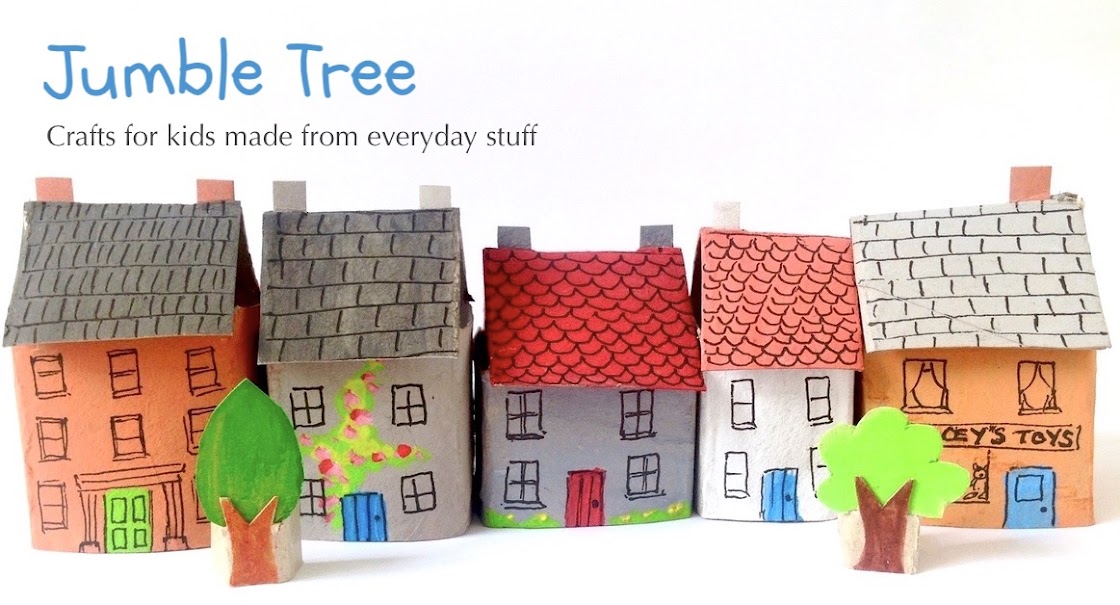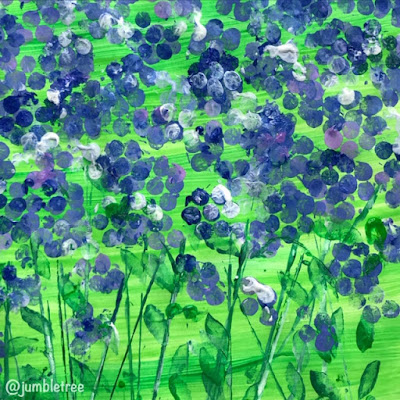These sleepy cats are no exception, and they're really not as tricky to make as you might think. It's all about the cutting and the folding. They are made in a similar way to our dog (called Scamp) and pig (called Oink!)
You will need
Toilet paper roll (ours was about 10cm long)
Small piece of spare card (from a cereal box or another TP roll)
Pencil
Ruler
Scissors
Craft glue
Paint
Sponge (optional)
Black pen.
1. Flatten the TP roll with your hand, then press firmly along the creases.
2. Draw two lines across the flattened tube - each one should be about the same distance from the ends, and shorter than the section in the middle (which will be the cat's body)
(For our roll which was roughly 10cm long, we drew lines that were 3cm from each end and the middle part was 4cm. See the picture below).
3. Then lift the tube and line up the two creases, in the middle (see below), and once you're happy, flatten the tube again, pressing along the two new side creases. There should now be four, hopefully evenly spaced crease lines around the tube.
4. While it's still flat, continue the pencil lines across the tube - free-hand is fine, the lines are just there as a guide.
5. Cut down all the creases at both ends to the pencil line. 8 cuts altogether.
6. Fold and press back all the flaps, except for two at opposite ends. These flat pieces will be the bottom part of the cat (the outstretched legs).
7. At one end, cut the top flap off, carefully along the crease. This square-isn piece will be your cats head. Keep it somewhere safe.
8. To define the legs, cut a thin triangle shape in the middle of the flat, unfolded piece of card. Cut right up inside your cat's body. Do this at both ends and round off the paws if you want.
9. Now, at the head end (the one with no top flap), fold one of the side flaps right back against the side of the tube, press firmly along the crease again, then fold this flap in the middle (so, effectively in half) so the top edge of the flap lines up with the bottom part of the flap (the edge of the body), and press firmly along the folds.
10. Do the same on the other side, then push these folded flaps inwards, towards the tube.
11. They should come together well enough, like little doors, to seal off the front of your cat.
They will jut out a bit in the middle (see RHS of photo below), but this is what we want, because this is where the head will be attached later. No need to use any glue at this stage.
12. Do exactly the same to the flaps at the other end, but this time, before you push them inwards, into the tube, cut a slit up the middle of the top flap, right up to the fold (cut a sliver of card out, to make a slightly larger slot - this makes things easier)
As you can see ours isn't exactly in the middle! But it still works, it doesn't need to be perfect. Push this top flap down, to cover the hole, and then press the two side flaps into the slot.
Essentially it's like closing a little box! And it should hold together without glue.
13. Now for the tail - draw on some spare card (we used another tp roll, so both sides were easy to paint)
We made our tail quite curly and quite fiddly to cut out! So do go for a simpler shape if you prefer.
Make the tail extra long at the body end, so you can slot it into the back.
It should stay in position, but take it out again for painting.
14. Take the square of card you cut off earlier for the head, and cut a gentle curve along one side, to form the cat's ears.
15. Time to paint, and we used a sponge, which was fun and really quick! For our marmalade cat we squirted some yellow and a little red poster paint onto a sheet of newspaper (with an extra sheet underneath) and used the sponge to mix the colours and press the paint onto the cardboard pieces. Using the sponge gives a lovely mottled effect.
Sponge both sides of the tail.
(might notice the newspaper's been recycled from the forget-me-not printing project!)
16. When the paint's dry, slot the tail back in (dab some glue on the end, if you feel it's a bit loose) and use a black pen (gel or thin marker pen) to draw on a face, plus claws on the front paws.
We added some tabby stripes to the face on the left with an orange Sharpie. You could draw stripes on the body too if you wanted.
Put a good blob of glue on the back of the head and attach to the top of the protruding flaps at the front. You could glue it so the head is facing forward, or glue the head angled to one side, as we did.
And here's my real sleepy cat!!













































































